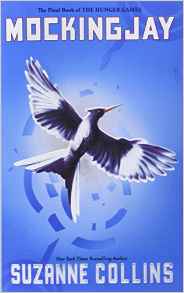Economic Lessons for Children from The Hunger Games
By Matthew Rousu

The fourth and final Hunger Games movie was released on November 20, bringing the second part of the third book (Mockingjay1) to the big screen. While I’ve found these books and movies entertaining, the value of this enterprise isn’t limited to entertainment. The Hunger Games might contain the best depiction of communism and its cousin—socialism—ever provided in a best-selling novel. Given the national popularity of self-avowed socialist Bernie Sanders and others who want increased government control over our lives, the lessons from these books are quite timely and desperately needed. The political and economic lessons from The Hunger Games are so relevant that our children, and pretty much everyone else, would do well to read them.
For those who haven’t read the books, I’ll give a brief background without any spoilers. But if you haven’t read the first one… stop now… get the book and read it… then come back. This article will still be here.
Still with me? Super! The country of Panem has been split into 12 districts and is run by a corrupt government referred to as The Capitol. As punishment for a rebellion that occurred 75 years ago, each year The Capitol holds the Hunger Games, an annual competition to which each district must send two teenagers—one male and one female—to compete. The 24 participants of the Hunger Games are thrown into an arena to fight to the death, with the sole survivor declared the winner.
In this fictional country of Panem, the 12 districts are told what to produce, and the men and women of those districts are assigned to work in those industries. Each district has a specialty: for example, coal mining in District 12, electronics production in District 3, and fishing in District 4. In Panem, a vital part of economic freedom is absent: the right to work in the job you choose.
This is the classic command economy. The decisions on what to produce and how to produce it are made not by markets but by a central government. It closely parallels what occurs or has occurred in actual communist countries. The government of the former Soviet Union controlled its citizens’ choices. Students were often assigned to a school based on the government’s future job expectations for that student. Similarly, workers were often assigned to specific jobs. When they were lucky, they were assigned a job near home. Sometimes, the Soviet Union’s government required citizens to move to jobs in different (and less appealing) geographic areas of the country.2
The Hunger Games also does a good job of showing the poverty that results from this form of government control. An economy is not well-served when government violates people’s right to sort themselves into the work they can best accomplish. Panem’s government does this, and, as a result, its people are poor.
This, too, is consistent with what has happened in communist countries. A comparison of North and South Korea demonstrates the power of markets versus the horrors of communism. While both countries were in about the same economic position 62 years ago, at the end of the devastating Korean War, North Korea became communist while South Korea embraced the mixed economy with a heavy dose of economic freedom in the mix.3 The GDP per capita today in South Korea (in U.S. dollars) is about $34,000, while in North Korea it is $1,800.4 North Koreans are starving and without electricity at night. South Koreans are thriving. North Korea isn’t an isolated case. In the former Soviet Union, the average person spent over an hour a day standing in lines to buy needed products.5 The lines existed because without market-based prices and incentives, there were often shortages of food, shoes, clothing, and other essential products. The USSR eventually collapsed, due in large part to the inability to sustain economic growth. This is not surprising when so much time was spent not on productive activities, but on simply waiting in line. In the 1950s, China’s Mao Zedong abrogated farmers’ property rights, with disastrous results:6 in the 1950s and early 1960s, millions of Chinese citizens starved to death.7 The evidence is clear: when you don’t let markets guide production decisions and, instead, rely on a central government, people suffer.
For more information, see Communism, by Bryan Caplan in the Concise Encyclopedia of Economics.
Not everyone suffers equally, however. The third realistic depiction of communism in The Hunger Games is that the privileged class lives better than most. In Panem, those living in The Capitol enjoy political connections and can oppress those in the other districts. They are rich—far richer than others in their country—and almost certainly use the government to fund their lifestyles. This is partially consistent with real-world communist countries, where the nomenklatura, the class of people holding positions of authority within the communist party,8 lived much better than the average person. In real-world communist countries, the nomenklatura sometimes lived better because they received products that nobody else received: military officers, for example, received cars.9 Other reasons that they lived better included receiving first priority to obtain products without waiting in lines—often because they would trade favors with other members of the nomenklatura—and better health care and education.10 That said, The Hunger Games seems to have exaggerated the wealth of the nomenklatura, as they were not necessarily rich by U.S. standards. As discussed in Henderson, McNab, and Rózsás (2005), the “luxury” vacation spots visited by the nomenklatura were no more luxurious than a Holiday Inn.11
A final way in which The Hunger Games correctly illustrates the horrors of communism is that the ruling class uses violence to oppress its citizens. In The Hunger Games, they do this to prevent free speech, to prevent people from moving beyond their own district, to control the media, and to control and oppress the citizens of Panem. Real-life communist governments also imposed such restrictions. In the former Soviet Union, criticism of the government (the government called it “propaganda”) was punished by a “deprivation of freedom for a term of six months to seven years.”12 Soviet citizens were also prohibited from leaving the country without permission.13 Even today, although the Chinese government has made some progress towards freedom, it arrested 2010 Nobel Peace Prize winner Liu Xiaobo along with citizens seeking due process protection for defendants.14 In China, those who disagreed with communism worked 14-hour days under brutal conditions in hundreds of forced-labor camps.15 In Cuba under Fidel Castro, parents who taught children the benefits of capitalism (or anything opposing communism) could be sentenced to multiple years in jail.16
Unfortunately, many victims of communism died. Estimates of the number of people that such governments have killed over the past century exceed 50 million.17The Hunger Games allows an opportunity to introduce these facts to children.
In addition to learning the horrors of communism or of big government in general, people can learn other economic lessons from The Hunger Games. A scholarly paper by economists Jeffrey Cleveland, Kim Holder, and Brian O’Roark18 and a presentation by economist Anne Macy19 discuss several economic concepts that are found in The Hunger Games series, including the importance of labor mobility, how lack of private property rights prevents people from saving or protecting assets, and the emergence of black markets.
Middle and high schools across the country spend countless hours on topics such as the celebration of our differences, the importance of recycling, the perils of global warming and other big-government causes. When was the last time your child came home from school talking about how governments have too much power? That governments control too much of the economy, too much of our lives? My guess is that your answer is “Never.” For many children growing up in America, the idea of communism can seem pretty far-fetched. Many would struggle to imagine just what horrors can ensue when a government becomes too big and powerful. The Hunger Games shows the danger of big government in an entertaining series that kids love, and we should encourage our schools to point out the important economic lessons in these books.
Suzanne Collins, Mockingjay. Amazon.com.
Drew McIntosh and Desmond Odugu, “The Soviet Education Model: Russia’s Communist Legacy in Schools Past and Present.” Education and Development in Developing Economies.
Grolier Multimedia Encyclopedia, “Union of Soviet Socialists Republic.” Retrieved November 12, 2015.
Federation of American Scientists, “Russia’s Physical and Social Infrastructure: Implications for Future Development.” December 2000.
James Gwartney, Robert Lawson, and Joshua Hall, Economic Freedom of the World: 2015 Annual Report. 2015. PDF file.
The CIA World Factbook. South Korea and North Korea. Retrieved November 13, 2015.
Hedrick Smith, The Russians. 2012. Random House, New York.
Tyler Cowen and Alex Tabarrok, Modern Principles of Economics. 2009. Worth Publishers, London, p. 111.
Alex Tabarrok, “The Secret Agreement that Revolutionized China.” 2012.
J.D. Ping Li, “Rural Land Tenure Reforms in China: Issues, Regulations, and Prospects for Additional Reform”. 2003. FAO Corporate Deposit Repository.
Daniel Southerland, “Uncounted Millions: Mass Death in Mao’s China.” 1994. Washington Post. July 17, 1994.
Yang Jisheng, Tombstone: The Great Chinese Famine, 1958-1962. 2013. Farrar, Straus and Giroux; Reprint edition, New York.
P.H. Collin (Ed.), Dictionary of politics and government. 2004. A&C Black. London, United Kingdom.
David R. Henderson, Robert M. McNab, and Tamás Rózsás. “The Hidden Inequality in Socialism.” 2005. The Independent Review, 9 (3). Pp. 389-412.
Ibid.
Ibid.
RSFSR Criminal Code, Article 70.
An Amnesty International Report, Prisoners of Conscience In The USSR: Their Treatment and Conditions. 1980. Amnesty International Publications, London, England, p. 3.
An Amnesty International Report, Prisoners of Conscience In The USSR: Their Treatment and Conditions. 1980. Amnesty International Publications, London, England, Pp. 45-51.
Laogai Research Foundation, “Censorship.” Retrieved November 14, 2015.
Laogai Research Foundation, Laogai Handbook. 2008. PDF file.
The Constitution of the Republic of Cuba. 1976 (Amended 2002). Retrieved from Constitutionnet.org PDF file.
U.S. Government Printing Office, United States of America Congressional Record, V. 146, Pt. 8, June 13, 2000 to June 21, 2000: Proceedings and Debates of the 106th Congress Second Session. p. 11378.
Stéphane Courtois et al., The Black Book of Communism: Crimes, Terror, Repression. 1999. Harvard University Press, Cambridge, MA.
Jeffrey A. Cleveland, Kim Holder, and Brian O’Roark, “The Economics of The Hunger Games.” 2015. Presented at the NETA Teaching Conference.
Anne Macy. “Economics of the Hunger Games.” 2015. Presented at the Federal Research Bank of Dallas Global Economic Forum. PDF file.
*Matthew Rousu is Professor and Warehime Chair in the Department of Economics at Susquehanna University. He writes about pedagogy, experimental auctions, and political economic issues. You can follow him on twitter @MatthewRousu.

